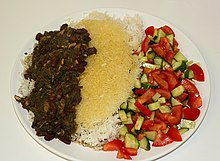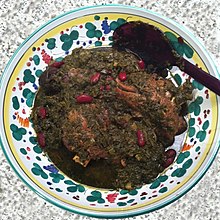|
Ghormeh sabzi
Ghormeh sabzi (Persian: قورمه سبزی) or Khoresht sabzi (Persian: خورشت سبزی), also spelled qormeh sabzi, is an Iranian herb stew. It is considered the national dish and is a very popular dish in Iran.[1] Ghormeh sabzi has different variants, which are based on the difference between beans and meat. Preparation The main ingredients are a mixture of sauteed herbs, consisting mainly of parsley, leeks or green onions, and coriander, seasoned with the key spice of dried fenugreek leaves. The herb mixture has many variations.[2] Any dark bitter greens can be used, such as kale, mustard greens, or turnip greens, although none of those are part of the original recipe.[3] This mixture is cooked with kidney beans, yellow or red onions, black lime (pierced dried limou-Amani Persian lime), and turmeric-seasoned lamb or beef. The dish is then served with polo (Persian parboiled and steamed rice) or over tahdig.[4] The Financial Times noted that there is much disagreement among Iranians on the ingredients used in the stew.[5] ServingGhormeh sabzi, a flavorful stew, is traditionally served with basmati rice. However, it can also be eaten with flatbread, Shirazi salad (cucumbers, tomatoes, onions, and herbs), and a yogurt-cucumber dip.[6][better source needed][7] Cultural importanceSelf magazine listed ghormeh sabzi as one of twelve of the most meaningful dishes among cultures passed down among families.[8] The Tehran Times wrote that the dish "is one of the most prominent dishes in Persian culinary heritage."[9] The undisputed King of Persian stews is Ghormeh Sabzi, with the Queen being Fesenjan, a pomegranate and walnut chicken stew. The crown jewel of this dish is its unparalleled depth of flavor. A symphony of fenugreek, cilantro, parsley, and dried limes creates a savory-sour symphony, enhanced by the comforting richness of beef and kidney beans.[10] Iranians in the diaspora traditionally celebrate "International Ghormeh Sabzi Appreciation Day" two days after Thanksgiving.[11] Ghormeh sabzi is the first Iranian dish served in outer space, by astronaut Jasmin Moghbeli.[12] See alsoReferences
|
||||||||||||||||||||
